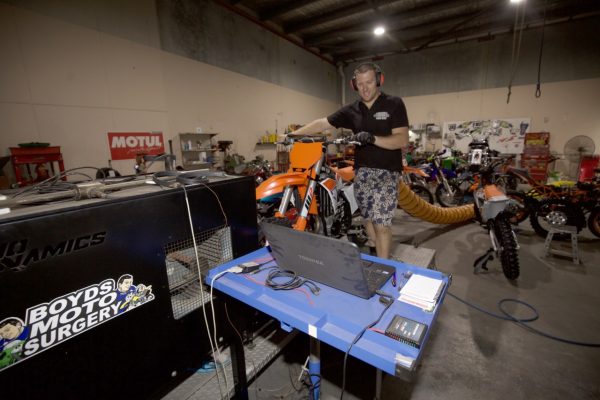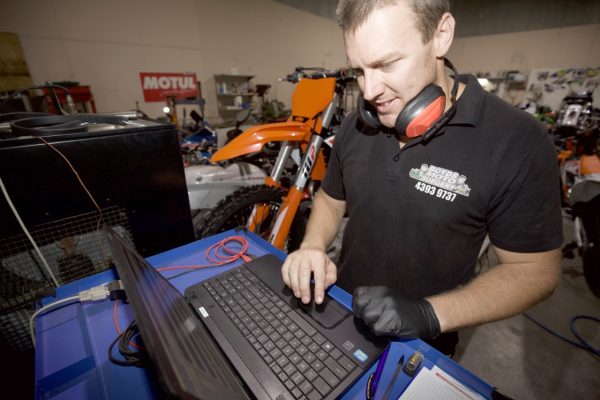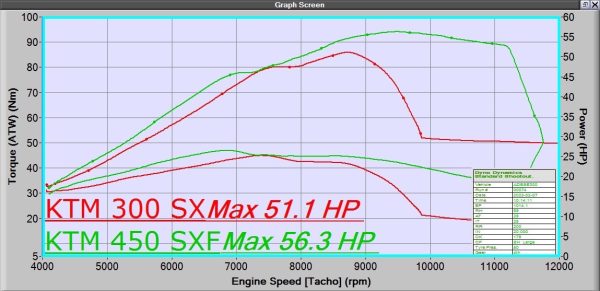The age old question of two-stroke or four-stroke, we put them on the dyno to find the real figures and the results blew us away.
If the industry was calling for something different from KTM then I would assume it would be a 500cc two-stroke so why did KTM go with the 300cc capacity? Well the simplest answer is that it is easier and less costly for them to produce the 300cc than a 500cc. The 300 uses the 250 SX as its base platform whereas a 500cc would require an entirely different engine design. KTM would have had to produce an entirely new set of engine cases, crankshaft, connecting rod and cylinder to accommodate a 500cc capacity making development and manufacturing a lot more expensive. So we thought we’d pit the 2023 KTM 450 SX-F vs 300 SX on a dyno to see which is better.
The second part to this answer is that an old CR500R produced roughly 56hp whereas the 300SX makes 51.1hp but over a broader rpm range making it easier to ride and easier to control. With today’s engine designs and fuel injection a 500cc two stroke is likely to produce well above 60+hp making them absolutely ridiculous to try and ride. With all modern 450cc four-strokes producing power in the range of 50 to 60hp it would absolutely be unfair on paper to expect them to have to race against a 500cc producing 60+hp. The other side to this is that it is very unlikely that anybody could pilot a two-stroke 500cc making so much power to the finish line over a 40 minute race in front of a 450cc four-stroke that is easier to ride and easier to control. Let’s find out with our 2023 KTM 450 SX-F vs 300 SX dyno test!

2023 KTM 450 SX
The new 2023 model KTM 450 SX has a very strong engine. In actual fact it is one of the strongest 450cc production bikes on the dyno to the current date. It only seems fair if we are going to put the 300 SX up against anything then it should be one of the strongest bikes in the class. For this reason we chose to dyno the 450 SX-F as our starting point for our comparison.
The 450 produces 56.3 peak horsepower which is very strong for a production engine. I have seen well known race teams in Australia not be able to achieve this figure in the past so for a production engine to reach this is very respectable. The 450 engine has a steep curve with a slight dip in power between 7,000 and 8,500rpm before reaching a rev ceiling of 11,000rpm. Peak power is reached around 9,500rpm therefore you want to be shifting gears right around this area.
If you were to rev the bike any further then you are losing up to 2hp before the power drops right off after 11,000rpm. The torque reaches 48Nm right before 7,000rpm before slowing dropping off. Personally I would like to spend some time to tune out the dip in power between 7,000 and 8,500rpm but overall the 450 SX-F engine is very strong and very competitive in its class.

2023 KTM 300 SX
The 300cc SX engine is strong and produces significantly more power than the 250 SX engine. The 300 engine has a steep curve with a large dip in power between 7,500 and 8,800 where it reaches peak power of 51.1hp. It will be interesting to see if we notice this dip once we get on the track as it is quite a significant dip on the dyno that could potentially be sorted out with a few mapping and timing changes. The 300 reaches peak torque at 7,500 RPM with 45Nm of torque.
Two-strokes are generally lacking in this department so 45Nm of torque is a respectable number. The 300 engine produces a decent peak horsepower figure which I can confirm is actually on par and even better than some other 450cc brands. The dip in power after 7,500rpm is a little concerning though. It could come down to a mapping issue or it could even be something like airbox shape and design or even exhaust design. Time will tell when once these machines become a little more popular and I get a chance to do some tuning and performance work with them.

HEAD TO HEAD
When you look at both dyno graphs next to each other you can clearly see the 450 has a power curve that is much broader than that of the 300’s. The 450 continues to rev another 2,000rpm past where the 300 redlines however at 7,500rpm they both produce exactly the same horsepower and torque. The 450 produces an extra 5.2hp compared to the 300 and an extra 3Nm of torque. The torque is greater on the 450 through the entire rev range even though it starts to taper off at 7,000rpm it doesn’t taper off as steep as that of the 300.
The 450 has great over-rev and keeps revving past the point of making peak horsepower whereas the 300 drops off immediately after making peak power. This unfortunately can be difficult to manage on the track and requires much more precise gear changes. Both have a dip in power between 7,000 and 8,500rpm which is concerning but we will have to wait until we track test the two bikes to see how that translates on the track.
On paper the 450 definitely produces more power and over a broader power curve which generally makes the bike easier to manage on the track. The power curve on the 300 is narrow which means the rider will need to keep the bike in the meat of that power curve requiring more throttle and clutch control as well as being much more precise with the gear changes.

Words | Mat Boyd
